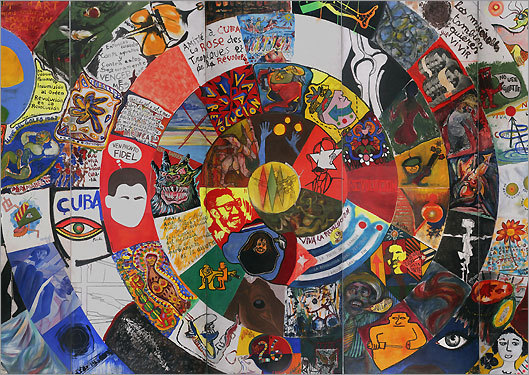Because Cuba is a highly diverse country, its art
is a direct reflection of that diversity that Cubans endear. For many Cuban artists, art is not only
a means of expressing themselves and their views but also with the underlying
purpose of documenting a moment in their history and ways of life as well. There are different styles throughout
the decades and centuries, but for the most part, the most popular form of art
is painting – of all kinds. Many
muralists and street artists have gone on to become quite famous, such as
Amelia Peláez, José Guadalupe Posada, and Diego Rivera.
The 1920s were the beginning of changes in the art
movements in Cuba, starting with the Vanguardia artists. These were artists who generally
rejected all of the traditional art forms being taught in Cuban art schools at
that time to opt for the more modern European (and especially French) styles
that were emerging: surrealism, cubism, etc. Some of the prominent Vanguardia
artists were Antonio Gattorno and Eduardo Abela.
 |
| Eduardo Abela |
When Castro took over in 1959, they were pretty
much cut off from the American and European artistic movements that drove their
own influences. Most serious artists continued their studies and work abroad at
this time. But through the 1970s
and 1980s, artists were beginning to teach younger artists about art as a means
of expression, and soon that translated into seeing artists push freedom of
speech and expression.
There is a whole class of artists who have been
deemed as “Naïve
Artists.” Since the
established artists pride themselves on their education and their studies, to
be called a Naïve Artist is somewhat meant in a unbecoming connotation. These
styles are characterized by the lack of perspective and bold colors. Usually depicting scenes of rural life
and religious deities, it also shows typical Cuban and Afro-Cuban life, generally
portraying people enjoying life amidst hard times.
| Example of naïve art |
Since the
Spanish arrived in Cuba, people have been writing in and about Cuba as well.
Poetry has always been a popular genre of literature, mostly in the classic
styles dominating Spain at the time. Nature has always been a common theme.
The 19th
century brought along new changes in Cuban literature as Cuban writers began to
find their own voice. Neoclassicism with references to Greek and Roman
mythology was one of the early influences upon Cuban writers. Neoclassicism
merged into Romanticism with prominent writers such as José María Heredia, poet
Juan Clemente Zenea, and José Martí.
Martí, along with Julián del Casal helped Cuba to bridge the transition
after independence into the modern literary movements.
 |
| Jose Martí |
Literature
changed again with a group of writers collectively called the “Generation of
the Fifty.” It was mostly comprised of writers who were born between about 1925
and 1945. Among other things,
these writers tended to add a new element to Cuban literature: colloquialism. It
seems that literature at this time bluntly mirrored the art movements during
these decades as well: new-Romanticism, surrealism, and origenist styles were
emerging in poetry as well as prose. Some of the prominent authors from this
era are Pablo Armando Fernández, Heberto Padilla, Carilda Oliver Labra. Nancy
Morejón, and Raúl Rivero.
 |
| Nancy Morejón |
 |
| Hemingway with his cat. |
Not only did
some Cuban writers work from abroad, but the opposite also happened as well.
American writer Ernest Hemingway (famous for his novels The Sun Also Rises, The Old Man and the Sea, and For Whom the Bell Tolls) spent much of
the 1940s and 1950s living in Cuba where he wrote parts of For Whom the Bell Tolls. I’ve visited the home where he grew up in
Oak Park, Illinois years ago. He apparently left 4000-6000 books in a bank
vault in Havana when he left Cuba after Castro took over, eventually moving to
Idaho. He killed himself in the
early 1960s, despondent partly over money problems and partly over his
manuscripts he left in Cuba, among other things.
Up next:
music and dance

No comments:
Post a Comment